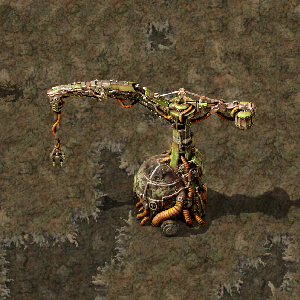Agricultural tower
| Agricultural tower |
|
Recipe |
|||||||||||||
| ++++ → | |||||||||||||
|
Total raw |
|||||||||||||
| +++++ | |||||||||||||
|
Map color |
|||||||||||||
|
Health |
|
||||||||||||
|
Resistances |
Fire: 0/100% |
||||||||||||
|
Stack size |
20 |
||||||||||||
|
20 (1 stack) |
|||||||||||||
|
Dimensions |
3×3 |
||||||||||||
|
Energy consumption |
100 kW (electric) |
||||||||||||
|
Mining time |
0.2 |
||||||||||||
|
Prototype type |
|||||||||||||
|
Internal name |
agricultural-tower |
||||||||||||
|
Required technologies |
|||||||||||||
|
Produced by |
|||||||||||||
| This article is a stub, and not comprehensive. |
|---|
| You can help this wiki by expanding it. |
![]() Space Age expansion exclusive feature.
Space Age expansion exclusive feature.
The Agricultural tower is a machine unlocked on Gleba![]() . It automatically harvests and re-plants trees in its range, provided that it is supplied with seeds obtained via fruit processing.
. It automatically harvests and re-plants trees in its range, provided that it is supplied with seeds obtained via fruit processing.
The Agricultural tower can plant either Yumako seeds![]() or Jellynut seeds
or Jellynut seeds![]() . The agricultural tower's working area is broken up into 3x3 tile sectors - if one of these sectors is completely filled with a viable soil type, and the agricultural tower has a matching seed in its inventory (Artificial yumako soil
. The agricultural tower's working area is broken up into 3x3 tile sectors - if one of these sectors is completely filled with a viable soil type, and the agricultural tower has a matching seed in its inventory (Artificial yumako soil![]() or Overgrowth yumako soil
or Overgrowth yumako soil![]() for yumako seeds, and Artificial jellynut soil
for yumako seeds, and Artificial jellynut soil![]() or Overgrowth jellynut soil
or Overgrowth jellynut soil![]() for jellynut seeds), then it will automatically plant the seed in that area. Hovering the cursor over an agricultural tower reveals its range, clearly broken up into the 3x3 sectors; each tile in a sector will be colour coded, with a green tile representing a tile that contains a viable soil type, a yellow tile indicating that it could contain a viable soil type if it were to be placed there, and a red tile indicating that this tile is outside the biomes in which the various soil types may be placed.
for jellynut seeds), then it will automatically plant the seed in that area. Hovering the cursor over an agricultural tower reveals its range, clearly broken up into the 3x3 sectors; each tile in a sector will be colour coded, with a green tile representing a tile that contains a viable soil type, a yellow tile indicating that it could contain a viable soil type if it were to be placed there, and a red tile indicating that this tile is outside the biomes in which the various soil types may be placed.
Yumako seeds will grow into a Yumako tree![]() , whereas Jellynut seeds will grow into a Jellystem
, whereas Jellynut seeds will grow into a Jellystem![]() . While a tree may be harvested by hand or by bot before it is finished growing, the agricultural tower will wait until it is fully grown to harvest the tree, outputting 50 of either Yumako
. While a tree may be harvested by hand or by bot before it is finished growing, the agricultural tower will wait until it is fully grown to harvest the tree, outputting 50 of either Yumako![]() or Jellynut
or Jellynut![]() .
.
Unlike most other methods of resource gathering in the game, agricultural towers do not benefit from mining productivity research, and they have no module slots. Each processed fruit has a 2% chance to return its respective seed, so the expected number of seeds that each tree produces is one - the same number of seeds that was used to produce the tree. Initially, this may restrict efforts to grow plantations, especially if fruits are allowed to spoil before being processed, which can actually result in the effective stock of trees and seeds diminishing. However, fruit processing does benefit from productivity - either via productivity modules in an assembling machine, or via the 50% inbuilt productivity of the biochamber![]() . Using just a biochamber with no extra productivity modules takes the expected seeds each tree returns from 1 to 1.5.
. Using just a biochamber with no extra productivity modules takes the expected seeds each tree returns from 1 to 1.5.
Note that this is only an expectation - there are no underlying mechanics that guarantee 50 fruits will return any number of seeds. It is entirely possible that one might process all 50 fruits harvested from a single tree, or even multiple trees, and obtain no seeds in return.
Agricultural towers may be activated or deactivated via the circuit network. This can be useful to avoid letting excess fruit back up, as they may eventually spoil and be wasted - and even if it does not, the extra time spent waiting to be processed decreases the freshness![]() of the item, which in turn may decrease the freshness of recipes that consume this item.
of the item, which in turn may decrease the freshness of recipes that consume this item.
